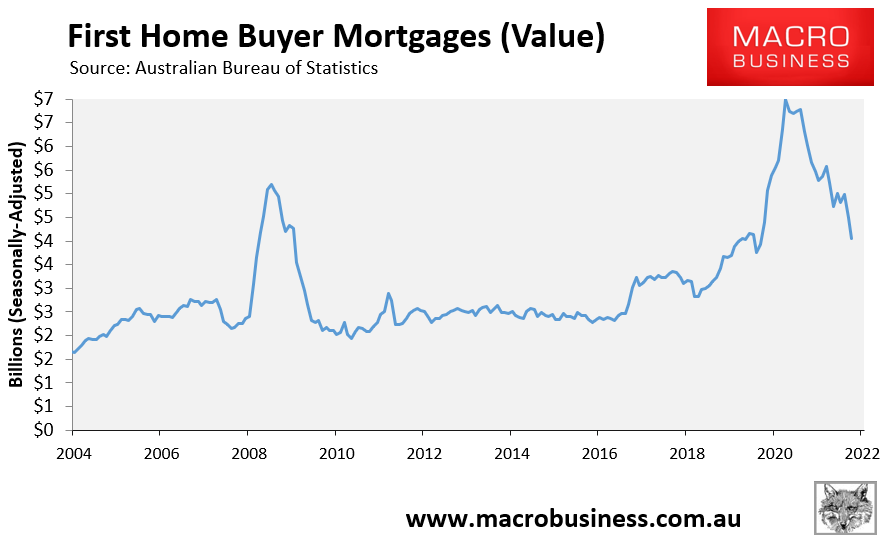PropTrack’s Director of Economic Research, Cameron Kusher, has penned a detailed article blaming Australia’s rental crisis on a suite of regulatory decisions over recent years that have dis-incentivised property investors from providing rental housing, and thereby driven a chronic rental shortage:
If we go back to 2014… the value of lending to investors was at its highest share of housing finance commitments on record…
And then the banking regulator stepped in. The Australian Prudential Regulation Authority (APRA)… announced the introduction of macroprudential controls on lending in late 2014… [This included] a speed limit on credit growth to investors of 10% annually…
As a result of these initial macroprudential and ongoing changes to international banking rules around mid-2015, we started to see lenders in Australia charge mortgage interest rate premiums for investor loans and interest-only loans.
These higher interest-rates were due to the fact that investor loans were perceived as being more risky…
In March 2017, there was further intervention from APRA… Further APRA intervention occurred in April 2018…
Over this period, we also saw many state governments increase land tax rates for investors, with larger increases for overseas investors and investors leaving properties vacant.
The by-product of all these changes was that it became a lot more expensive and a lot less desirable for people to invest in real estate.
There has been a steady increase in investors selling their properties since 2014, exacerbated through the pandemic, and a significant drop in new investors entering the market, reducing the supply of rental stock as the population of the country has continued to grow and demand for rental accommodation has increased…
By making it more expensive and more difficult for investors to access finance, and more expensive for investors to hold residential property through increased land taxes, we have reduced the supply of rental stock…
These types of analysis need to differentiate between property investors purchasing existing dwellings (the majority) and those buying new off-the-plan homes (the minority).
The former does not add to rental supply in aggregate because any home that is purchased by an investor is one less home available for an owner-occupier. By the same token, if an investor exits the market and sells to an owner-occupier, then rental supply falls by one unit, but rental demand also falls by one unit (other things equal), balancing things out.
Curiously, Kusher’s main solutions for the rental crisis are for investors to purchase existing homes and to encourage more first home buyers (FHBs) into the market to relieve rental demand:
The only way to resolve this situation is to either increase the supply of rental stock or decrease the demand.
Supply can be increased by building more homes, but if we plan now, it will take a number of years until they are built. Or we can boot supply through increased investor purchasing of existing homes. An increase in investors purchasing is a challenge in the current environment with higher interest rates and higher serviceability hurdles to overcome.
The easiest way to slow demand for rental accommodation is to assist more people to buy their first home.
If investors merely buy established homes, they do not add to overall supply, since they reduce the stock of homes available for owner-occupiers by the exact same proportion of the increase in rental accommodation. We will merely have substituted a home for sale for a home to let.
The same goes for FHBs that purchase existing homes. If they do so, then they remove a potential home for rent, leaving the housing supply-demand balance unchanged (other things equal).
Moreover, the federal government massively stimulated FHB purchases over the pandemic, and yet the rental market has tightened more than ever:

This suggests that getting FHBs to purchase more homes won’t solve the rental supply issue.
Finally, it is curious that Cameron Kusher did not attack the Albanese Government for ramping immigration to record levels via:
- Lifting the permanent non-humanitarian migrant intake to a record high 195,000 a year;
- Turbo-charging temporary migration by:
- Expanding work rights for international students by:
- Uncapping the number of hours international students can work while studying for another year; and
- Extending the length of post-study work visas by two years.
- Committing to clear the ‘backlog’ of “nearly one million” visas awaiting approval.
- Expanding work rights for international students by:

Labor advertisement on visa ‘backlog’.
Where will the hundreds of thousands of new migrants live when there is already a massive shortage of rental homes across Australia? On the streets? In tents?
The only possible outcome is even lower rental vacancies and higher rents, as well as thousands of Australians being thrown into homelessness.
Keeping immigration at moderate levels would do far more to ease Australia’s rental crisis than the solutions Kusher proposes or trying to build more homes.
Instead of tackling the concocted “visa backlog”, Labor should instead fix the chronic backlogs in social housing and rental accommodation, both of which will be made so much worse by its record immigration push.
So why not call the government out?

